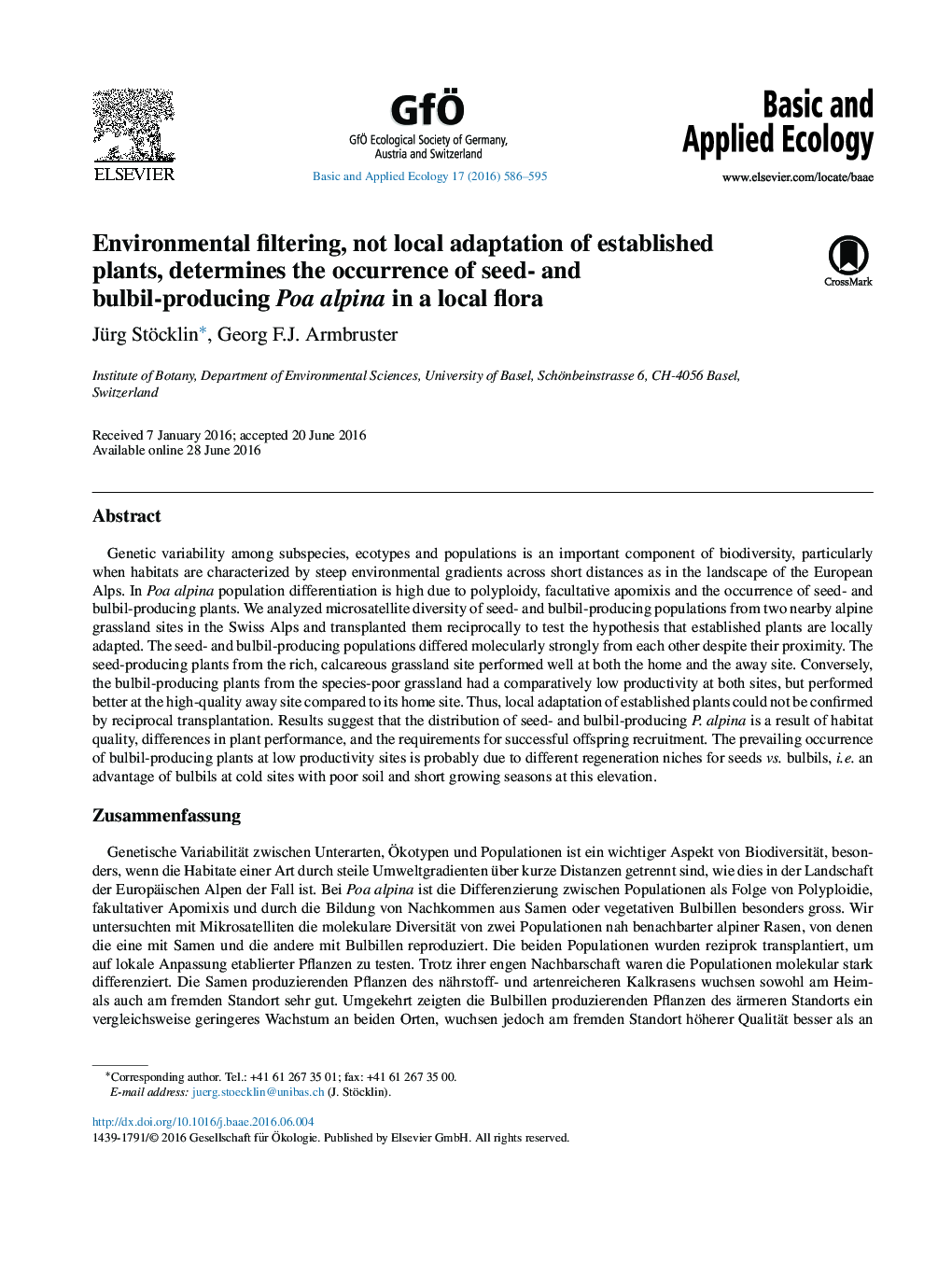| Article ID | Journal | Published Year | Pages | File Type |
|---|---|---|---|---|
| 4383827 | Basic and Applied Ecology | 2016 | 10 Pages |
Genetic variability among subspecies, ecotypes and populations is an important component of biodiversity, particularly when habitats are characterized by steep environmental gradients across short distances as in the landscape of the European Alps. In Poa alpina population differentiation is high due to polyploidy, facultative apomixis and the occurrence of seed- and bulbil-producing plants. We analyzed microsatellite diversity of seed- and bulbil-producing populations from two nearby alpine grassland sites in the Swiss Alps and transplanted them reciprocally to test the hypothesis that established plants are locally adapted. The seed- and bulbil-producing populations differed molecularly strongly from each other despite their proximity. The seed-producing plants from the rich, calcareous grassland site performed well at both the home and the away site. Conversely, the bulbil-producing plants from the species-poor grassland had a comparatively low productivity at both sites, but performed better at the high-quality away site compared to its home site. Thus, local adaptation of established plants could not be confirmed by reciprocal transplantation. Results suggest that the distribution of seed- and bulbil-producing P. alpina is a result of habitat quality, differences in plant performance, and the requirements for successful offspring recruitment. The prevailing occurrence of bulbil-producing plants at low productivity sites is probably due to different regeneration niches for seeds vs. bulbils, i.e. an advantage of bulbils at cold sites with poor soil and short growing seasons at this elevation.
ZusammenfassungGenetische Variabilität zwischen Unterarten, Ökotypen und Populationen ist ein wichtiger Aspekt von Biodiversität, besonders, wenn die Habitate einer Art durch steile Umweltgradienten über kurze Distanzen getrennt sind, wie dies in der Landschaft der Europäischen Alpen der Fall ist. Bei Poa alpina ist die Differenzierung zwischen Populationen als Folge von Polyploidie, fakultativer Apomixis und durch die Bildung von Nachkommen aus Samen oder vegetativen Bulbillen besonders gross. Wir untersuchten mit Mikrosatelliten die molekulare Diversität von zwei Populationen nah benachbarter alpiner Rasen, von denen die eine mit Samen und die andere mit Bulbillen reproduziert. Die beiden Populationen wurden reziprok transplantiert, um auf lokale Anpassung etablierter Pflanzen zu testen. Trotz ihrer engen Nachbarschaft waren die Populationen molekular stark differenziert. Die Samen produzierenden Pflanzen des nährstoff- und artenreicheren Kalkrasens wuchsen sowohl am Heim- als auch am fremden Standort sehr gut. Umgekehrt zeigten die Bulbillen produzierenden Pflanzen des ärmeren Standorts ein vergleichsweise geringeres Wachstum an beiden Orten, wuchsen jedoch am fremden Standort höherer Qualität besser als an ihrem Heim-Standort. Lokale Anpassung etablierter Pflanzen konnte folglich durch reziproke Verpflanzung nicht nachgewiesen werden. Die Ergebnisse legen nahe, dass das unterschiedliche Vorkommen von Samen bzw. Bulbillen produzierenden Pflanzen eine Folge ist der verschiedenen Habitatsqualität, der unterschiedlichen Wüchsigkeit der Pflanzen aus den beiden Populationen sowie der spezifischen Anforderungen an die erfolgreiche Etablierung von Nachkommen. Das ausschliessliche Vorkommen von Bulbillen produzierenden Pflanzen in Habitaten geringerer Produktivität ist wohl in erster Linie eine Folge unterschiedlicher Etablierungsnischen von Samen und Bulbillen, insbesondere, dem Vorteil von Bulbillen an kühleren Standorten nährstoffarmer Böden mit einer sehr kurzen Wachstumsperiode.
